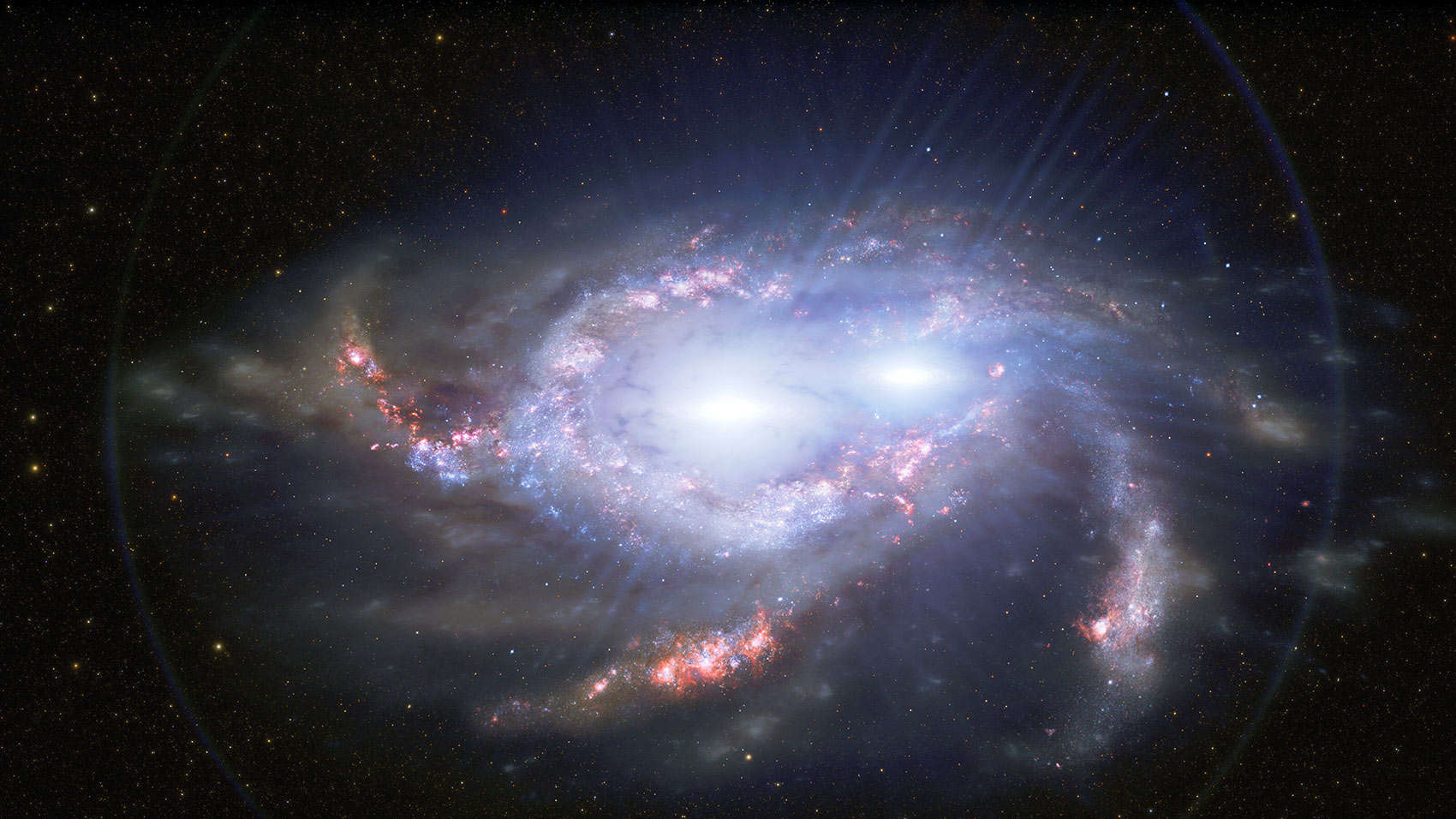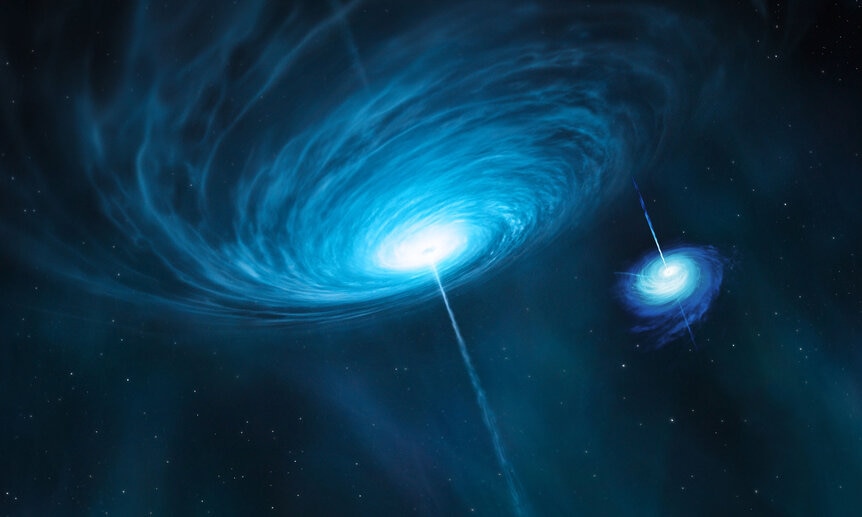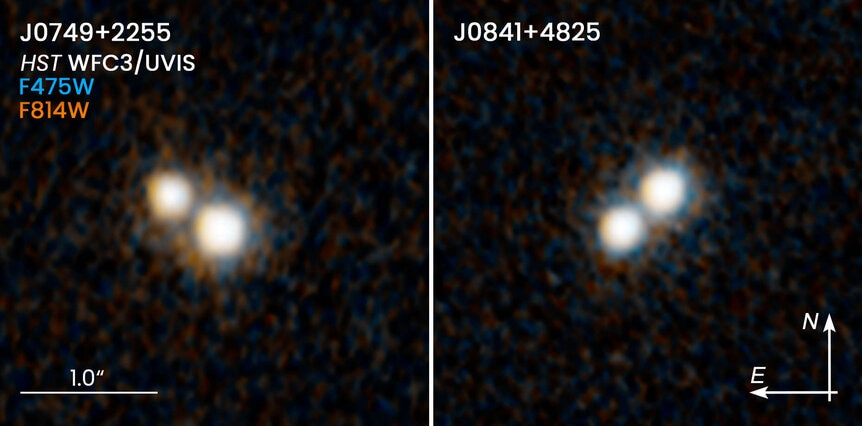Create a free profile to get unlimited access to exclusive videos, sweepstakes, and more!
A new way to find gigantic black holes paired up at the dawn of the Universe

Using what's really a pretty dang clever new technique, astronomers have discovered what appear to be two double-quasars (and possibly a third pair as well) billions of light years from Earth. This may help constrain how many of these ferocious objects existed when the Universe was young.
A quasar is a kind of active galaxy, a galaxy that has an actively feeding supermassive black hole in its center. As I've described before (in an article about binary quasars):
All big galaxies, and many smaller ones, have a supermassive black hole at their heart. As I have described approximately eleventy bazillion times before, if matter from the surrounding galaxy is falling into the core, it can pile up into a disk that orbits the black hole, slowly feeding it. The disk is incredibly hot and can shine incredibly luminously, easily outshining the rest of the galaxy. Sometimes, through forces not terribly well understood (though the magnetic properties of the disk are the likely culprit), twin beams of matter are launched up and down, away from the disk, with the matter moving at extremely high velocity, sometimes just a smidge slower than the speed of light.
Generically, such an object is called an active galaxy. If one of those beams happens to be pointed at Earth, we can see lots of light from across almost the entire electromagnetic spectrum, from radio waves to X-rays. We call an object like that a quasar.
We know that there are extremely massive black holes out there which may have grown to such enormous size when two big galaxies merge. The black holes fall toward each other, eventually orbiting each other and then, after billions of years, they can merge together into one bigger black hole. This implies we should find binary supermassive black holes, or at least two that are close together (say, within a few thousand light years of each other). However very few are seen, mainly because they're hard to discover.
The new research figured out a way to find some of them though, and it's super clever. Quasars are known to fluctuate in brightness, getting brighter and dimmer on a timescale of days, weeks or months. If two quasars are close together, one may get brighter than the other over time and vice-versa.
If they're so close together they appear as one blob, this effect can betray their dual nature. Say one is to the left of the other. If the left one is brighter, the blob will appear to be shifted a tiny bit to the left. If it then fades and the other gets brighter, the blob will shift a little bit to the right. The science of measuring the positions of objects on the sky is called astrometry, and so the scientists who worked on this double-quasar research call this idea astrometric jitter.
The satellite observatory Gaia has been surveying the sky for years, measuring the positions of billions of objects with incredible accuracy. If the center of what it thinks is a single object is seen to move back and forth over time, perhaps it's one of these rare double quasars.
The team first made a list of known quasars farther away than about 10 billion light years — anything closer than that and the extended light from the stars in the galaxy surrounding the black hole might interfere with the measurements. They found about 11,000 such quasars.
They then searched the Gaia database to see if the positions of any of these quasars suffered from recurrent jitter. Out of that list they found 15 (noting that there could be more that were missed because they were too close together to see any shift in the center).
The team submitted these 15 objects to be observed by Hubble as part of the “Snapshot” program: Very short exposures (typically 5 – 8 minutes) of targets that can be obtained between regularly scheduled observations. Four of the 15 were observed. Of these, one is clearly a quasar with a star very close by, so it's not a double quasar. A second was not resolved even by Hubble — it still appears as a single object — so its qualifications are uncertain.
But the other two pairs both appear to be double quasars, with two clearly resolved components each. However, we have to be careful here. It's possible that each is actually a single quasar but is gravitationally lensed: The gravity of a foreground galaxy between us and them can distort the light, creating multiple images of the same object. The team cannot rule this out, even after taking spectra of one of the double quasars (and finding it's about 11.5 billion light years away). Still, looking at the number of lensed quasars known they find the odds of it being a lensed single quasar is only about 5%, meaning they have 95% confidence it really is a double quasar.
To be fair it could also just be two active galaxies that happen to be close to one another, or a single extremely clumpy still-forming galaxy where two clumps happen to have massive black holes in them.
What's needed are more follow-up observations (including the 11 potential pairs not yet observed by Hubble) to try to rule out some of these possible confounding factors. However, the bigger point here is that the astrometric jitter idea worked. Over time Gaia may see more of these as well, since the longer it observes the sky the better its measurements get. Also, future sky surveys may improve on this technique, so even though it only yields a handful of double quasars now it may prove even more useful later.
The early Universe should have more double quasars, twin monsters roaring in the dark. Here's hoping we find more of them.





























